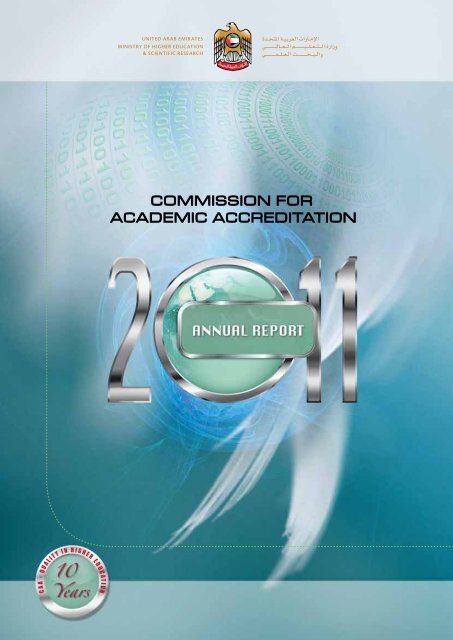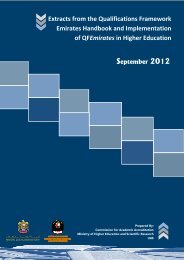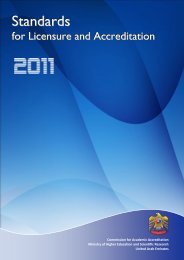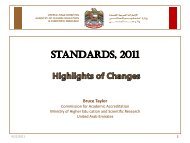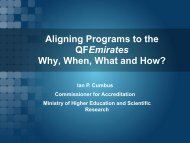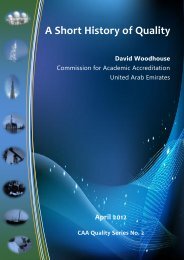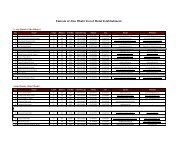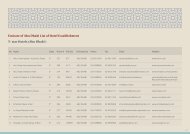2011 - CAA
2011 - CAA
2011 - CAA
You also want an ePaper? Increase the reach of your titles
YUMPU automatically turns print PDFs into web optimized ePapers that Google loves.
2commission for academic accreditation
PrefaceWith enlightened and visionary leadership in the United Arab Emirates, the long-termstrategy has been to develop a knowledge-based economy that is inextricably linked toa high quality tertiary education system. As higher education expands rapidly acrossthe UAE there is a need to regulate the establishment of non-federal colleges anduniversities, and ensure that rigorous standards are adopted within an ‘institutionalquality culture’ that pervades all activities, including teaching, research, supportservices and administration.The Commission for Academic Accreditation was established in year 2000 to developand implement Standards for institutional licensure and program accreditation,based on international best practice, to ensure a worthwhile and rewarding learningexperience for all students.The <strong>CAA</strong> was the first Accreditation Agency in the region, and it has established andmaintained a leading role across higher education in the Middle East, and played aninfluential part in the wider international sphere of higher education quality assurance.In <strong>2011</strong>, having completed its first decade of operation, the Commission has beenrecognized by the International Network for Quality Assurance Agencies in HigherEducation (INQAAHE) as one of few international agencies that have fully adoptedtheir ‘Good Practice Guidelines’.This formal Annual Report from the Commission focuses on the reporting year 2010-<strong>2011</strong> but it also highlights some of the history and landmarks in the genesis and earlyyears of the <strong>CAA</strong>.Nahayan Mabarak Al NahayanMinister of Higher Education and Scientific Research
2commission for academic accreditation
from the directorThe Commission for Academic Accreditation celebrated its 11th year in 2010-<strong>2011</strong>.Those eleven years have seen the agency mature such that it is now one among thefew agencies recognized by the International Network for Quality Assurance Agenciesin Higher Education (INQAAHE) for comprehensively adhering to its guidelines forgood practice. The <strong>CAA</strong> is increasingly taking a lead role within the Middle East andwill host the first Arab Network for Quality Assurance in Higher Education (ANQAHE)Conference in Abu Dhabi in December, <strong>2011</strong>.The Commission works with more than 70 institutions of higher education in the UAEand more than 560 programs to ensure adherence to the Standards for Licensureand Accreditation (<strong>2011</strong>). Through that work the <strong>CAA</strong> contributes significantly tothe development of quality assurance and to higher education in the United ArabEmirates. The Commission takes seriously its role as both a federal regulatoryagency, and as a proactive advocate for improving the quality of higher educationthroughout the United Arab Emirates. The work of the Commission is through a smallprofessional and support staff consisting of a Director, four Commissioners with wideranging experience as faculty, administrators and quality assurance officers and withexperience in North American, European, Asian and Australian quality assuranceinitiatives. The support staff of eight handles financial, logistical and document controlfor the work of the entire Commission.This is the first Annual Report of the Commission for Academic Accreditation and, assuch, reflects not only on the year just past but also engages in a longer view of theCommission since its inception.M. Badr Aboul-ElaDirectorCommission for Academic AccreditationEmail: badr.aboulela@mohesr.gov.ae
The Institutional ContextAs the <strong>CAA</strong> has developed over the past decade, so, too have the institutions servedby the <strong>CAA</strong>. From under 20 institutions at the outset, the number of institutionslicensed by the <strong>CAA</strong> is now over 70 with more applications for initial licensure underconsideration. The distribution of institutions in the UAE reflects the populationpattern with Dubai and Abu Dhabi having the vast majority of institutions and with theother Emirates having far fewer. The largest institutions in the Emirates are, however,not in Dubai or Abu Dhabi but rather in Sharjah and Ajman. The figures below showthe growth in the number of institutions in the UAE and the distribution of institutionsby Emirate.Growth of Licensed Institutionsin the UAE (through June, <strong>2011</strong>)6770605446403126161920228before 200020002001200220032004200520062007200820092010<strong>2011</strong>4commission for academic accreditation
annual report-<strong>2011</strong>Number of Licensed Institutions (by Emirate)292654 411dubaiabu dhabisharjahras al khaimahajmanfujairahumm al-quwainHighlights from the Year- The TrendsThe 2010-11 year saw the number of licensed institutions reach 70, the totalnumber of programs accredited surpass 560 and the number of students served by<strong>CAA</strong> institutions top 63% of the total number of students in licensed higher educationinstitutions in the UAE. Of the students enrolled in the non-federal and licensedinstitutions, 44% are Emirati.Total Vs Non-Federal Enrollmentin Higher Education Institutionstotalnon-federal770807838043474 4621483945515559517059876103431656182006-20072007-20082008-20092009-20102010-<strong>2011</strong>Ministry of Higher Education & Scientific Research5
The year was one in which the <strong>CAA</strong> approved 8 licensures or the renewal of licensures,and undertook 76 program accreditation visits. It did so at a lower cost per programthan in either of the previous two years.Number of Accredited Programs49756112 154870 93136 179 229 286340397Number of Accredited Programs by subject15011928 2819512310652582411arabic/islamic studiesart & designbusiness/managementcommunication/mediacomputer science/iteducationengineeringenglish language/literaturehealth sciencelaw & jurisprudencenatural/quantitativesocial/behaviouralotherbefore 200020002001200220032004200520062007200820092010<strong>2011</strong>6commission for academic accreditation
annual report-<strong>2011</strong>The year also included the completion of a thorough Self-Study for the <strong>CAA</strong> and anexternal review of the organization, a major revision of the Standards, the developmentof new Procedural Guidelines which will help guide the work of the institutions and thedevelopment of a new Handbook for External Review Team Members.The <strong>CAA</strong> made substantial progress on the implementation of its Strategic Planincluding a re-drafting of its mission statement and significant progress on each ofthe major goals of the plan.While the <strong>CAA</strong>’s prime responsibility is to the institutions and the people of the UAE,it can only exercise this responsibility appropriately if it is in touch with the worldwideQuality Assurance community in higher education. Through its links with ANQAHE,INQAAHE, and many reviewers from around the world, the <strong>CAA</strong>, and hence the UAE,both benefits from and contributes to the global developments in quality highereducation.Mission and PlanningThe <strong>CAA</strong> is committed to ensuring that institutions of the UAE adhere to their missionsand that they have a culture of planning which drives their work. Just as there is thatexpectation for the institutions of the UAE, the <strong>CAA</strong> has the same expectations foritself. An important activity of the 2010-<strong>2011</strong> year was the revision of the missionof the <strong>CAA</strong> to now read: “The Commission for Academic Accreditation is the FederalGovernment’s Quality Assurance Agency charged with promoting educationalexcellence across institutions of higher learning in the UAE. Through licensure ofpost-secondary educational institutions, and accreditation of individual programs, theCommission strives to assure high quality education, consistent with internationalstandards.”The year included, too, a thorough review and update of the <strong>CAA</strong> Strategic Plan. Withfour broad emphases on (1) ensuring quality and academic standards; (2) diversifyingservices; (3) ensuring effective operations, and (4) elevating the international profile,the plan highlights not only the regulatory work of the <strong>CAA</strong>, but also its consultativerole in quality assurance. Both roles are expressed through the work of the ExternalReview Teams, and the professional development workshops sponsored by the <strong>CAA</strong>.The plan underscores the commitment of the <strong>CAA</strong> to expanding its connections tothe larger world of international quality assurance. The plan, as well, has specific KeyPerformance Indicators which allow the <strong>CAA</strong> to measure its performance againstagreed upon benchmarks. The complete strategic plan is on the <strong>CAA</strong> website.Because the Strategic Plan of the <strong>CAA</strong> is a frequent reference point in discussionswithin the <strong>CAA</strong>, it has, in language taken from a summary of recent progress on theplan, “served to guide the agenda of <strong>CAA</strong> activities over the past two years.”Ministry of Higher Education & Scientific Research7
High Praise from the InstitutionsAs part of recognizing the <strong>CAA</strong> for its 10 years of service to the UAE, institutionalleadership was asked to comment. The comments, reflected in the quotations below,underscore the commitment of the <strong>CAA</strong> to its mission and its role of serving highereducation in the Emirates.“The <strong>CAA</strong>’s excellent standards for academic accreditation are very much in linewith international standards and these standards have a direct impact on the qualityof students, faculty and the academic programs at Abu Dhabi University.” Dr. NabilIbrahim, Chancellor, Abu Dhabi University.“Through its rigorous standards, covering the various dimensions of e-learning … andits ongoing constructive input and feedback, the <strong>CAA</strong> has supported HBMeU in everyshape and form to become a blue print for the recognition and accreditation of anew form of learning while ensuring that at all times it meets the highest standardsof excellence which will enable it to position itself as a leader and pioneer in onlineeducation at both regional and international level.” Dr. Mansoor Al Awar, Chancellor,Hamdan Bin Mohammed e-University.Revising the Standards for Licensureand AccreditationA major initiative of this past year was the revision of the Standards. The initialStandards for the <strong>CAA</strong> were those of 2000. Subsequent editions appeared in 2003,2005, and 2007. The revisions of 2010-<strong>2011</strong> built on the previous editions, and onthe experience of the <strong>CAA</strong> in working with the institutions of the UAE. The revisionprocess included review and advice from the Higher Education Institutions in theUAE, and a review by External Consultants. The resulting <strong>2011</strong> Standards include,in addition to sections on Mission, Governance, Academic Programs, Faculty andStaff, Students, Learning Support, Physical Facilities, Fiscal Matters, InstitutionalIntegrity, and Research, a new section on Community Engagement. The revisionscenter on broad principles of quality, but also include prescriptive “Stipulations” whichdefine the minimum thresholds for quality in a number of areas. The new editionof the Standards also includes an expanded glossary which will help bring greaterconsistency in the use of key higher education terms. The Standards also make areference to the UAE Qualifications Framework. The new Standards are posted tothe <strong>CAA</strong> website and a print edition in both English and Arabic will soon be availablefor the use of all institutions in the UAE.8commission for academic accreditation
annual report-<strong>2011</strong>Companion pieces to the StandardsImportant to the success of the implementation of the new Standards is thedevelopment of the Procedural Guidelines (one “Guideline” for each of the <strong>CAA</strong>processes of licensure, renewal of licensure, initial accreditation and renewal ofaccreditation). These “Guidelines” provide a “how to do it” blueprint or outline forinstitutions to follow when submitting materials for any of the processes of theCommission.External Review TeamsDuring the 2010-<strong>2011</strong> year, the <strong>CAA</strong> relied on the services of 164 reviewersrepresenting North America, Europe, Australia, Asia and areas of the Middle Eastoutside of the UAE. The reviewers are internationally recognized program specialistswho bring their program expertise and their understanding of quality assuranceto their judgments as to whether a program is in compliance with the Standards.With the reviewers, themselves, well versed in international quality assurance, thereview teams serve to give an international benchmark for the programs of theUAE compared to those offered elsewhere in the world. The <strong>CAA</strong> has also used theexpertise of External Review Teams for purposes of the renewal of licensure of severalUAE institutions. By using review teams for back-to-back visits and by schedulingteams well in advance, the <strong>CAA</strong> seeks to lower costs to institutions.Handbook for External Review TeamsDuring this past year, the <strong>CAA</strong> undertook a revision of its Handbook for ExternalReview Teams and did so to not only update the guidelines for review teams, butto provide review teams with a context for the rapidly changing higher educationenvironment of the UAE. The revised Handbook provides examples of how to do thereports which are an important part of the work of External Review Teams. Theexamples will lead to greater consistency in the way in which the teams do their work.The contextual material will assist External Review Team members in understandingthe rapidly changing and very diverse nature of the Higher Education Institutions inthe UAE. The resulting Handbook is a much more professional guide to the work ofthe External Review Teams.Ministry of Higher Education & Scientific Research9
Internal Quality AssuranceThe 2010-<strong>2011</strong> Year for the <strong>CAA</strong> included a major and very important effort by the<strong>CAA</strong> to reflect on and refine its own work. Building on the practices of other HigherEducation Quality Assurance agencies, the <strong>CAA</strong> undertook a Self-Study in the fall of2010. The study culminated in a review by a team of International experts (from theUS and from Ireland) and a summary report which affirmed that the <strong>CAA</strong> is operatingwithin the guidelines of good international practice for quality assurance agencies.To quote from the report of the external evaluators: “The self-study report producedfor this review is exemplary in its frankness and in the depth of its self-analysis. Theanalysis recognizes the strengths and also the weakness of the Commission andoutlines remedies and plans to meet these weaknesses.”Significantly, the self-study led the <strong>CAA</strong> to undertake revisions of many of its owninternal practices including revisions to evaluation forms used for External ReviewTeams, revisions to the document retrieval system, improvements to the way in whichreviews are scheduled and the timeliness with which they are carried out.The <strong>CAA</strong> also asks ERT members to evaluate the work of the Commission. The resultsof those evaluations are summarized in the charts which follow.Summary of data from Evaluation forms –Standards and their applicabilityClarity of the Standards and ease of useDepth of the Standards to guide institutionsin the development and implementation ofeffective quality assurance systems andprocess4.9Guidance from Commission on writing of theReport4.8 4.8 4.8Inclusivity of the Standards to foster institutionwide quality assurance4.7Overall quality of the Standards as comparedto internationally recognized standardsRigor of the Standards to ensure high qualityacademic programs4.5average score on a 1-5 scale(1-Poor/ 2-Unsatisfactory/ 3-Satisfactory/ 4-Good/ 5-V.Good)10commission for academic accreditation
annual report-<strong>2011</strong>Summary of data from Evaluation forms –Visit ArrangementsInitial contact and preliminary information on the visitOrganization of the visit scheduleOverall guidance from the CommissionerTime allotted for overall visitTravel arrangements to/from UAETravel arrangements within UAEUsefulness of Preparation DayUsefulness of TemplateUsefulness of the Handbook for External Review Teams54.94.9 4.94.8 4.84.7 4.74.6average score on a 1-5 scale(1-Poor/ 2-Unsatisfactory/ 3-Satisfactory/ 4-Good/ 5-V.Good)Ministry of Higher Education & Scientific Research11
UAE Qualifications Framework<strong>CAA</strong> has worked very closely with an important new initiative of the UAE, namelythe development of a UAE Qualifications Framework. The <strong>CAA</strong> Director servesas a member of the steering committee for the newly established QualificationsFramework Authority. The Framework promises to help all educational institutions atall levels to better align their curricula and their expected outcomes both within theUAE and in relation to educational systems in other parts of the world. As the NationalQualifications Framework is implemented, the <strong>CAA</strong> will monitor higher educationinstitutions as to their compliance. Adherence to the UAE Qualifications Frameworkis built into the <strong>2011</strong> Standards.12commission for academic accreditation
annual report-<strong>2011</strong>Institutional SupportThe <strong>CAA</strong> is committed to helping higher education institutions develop theirprofessional capacity. To that end, the Commission sponsored a number ofprofessional development workshops during the 2010-<strong>2011</strong> year. Many of thesewere co-sponsored by the British Council and hosted by institutions in Abu Dhabi,Dubai, or Ajman. Included in the workshops were topics on Strategic Planning (April,2010), Assessment (April, 2010), Benchmarking in Higher Education (January,<strong>2011</strong>), the UAE Qualifications Framework (April, <strong>2011</strong>), and Quality Assurance atthe Institutional Level (May, <strong>2011</strong>).Good Practice DatabaseAs the institutions of the UAE have matured, they have developed a number of ideasand approaches to serving the students of the Emirates. To both celebrate anddisseminate some of the better examples of quality in the delivery of higher educationservices in the UAE, the <strong>CAA</strong> is developing a database of “Good Practice” whichincludes good ideas from throughout the UAE. The “Good Practice” database will,during <strong>2011</strong>-12, be posted to the <strong>CAA</strong> website.Ministry of Higher Education & Scientific Research13
Improving the capacity for Quality:Benchmarking and Data CollectionThe <strong>CAA</strong> has long emphasized the importance of institutional data gathering orinstitutional research. During the 2010-11 year, this became even more importantas the <strong>CAA</strong> began the practice of evaluating the institutional research and qualityassurance operations of a campus each time that an External Review Team visitedthe campus. The <strong>CAA</strong> also sent special teams to several campuses with the expresstask of evaluating the institutional research and quality assurance operations of thecampus. And, too, the Commission sponsored a workshop on “benchmarking” whichhelped institutions to not only better understand the concept of benchmarking, butto think through the issue of selecting the right “peer” institutions against which tocompare themselves.The Data Warehouse initiativeThe <strong>CAA</strong> is very much involved in a Ministry of Higher Education and ScientificResearch initiative to ensure that reliable and comprehensive data is gathered on theinstitutions of the UAE. There are few more important initiatives that can have theimpact on higher education institutions in the UAE. A reliable database of informationcan provide assistance in benchmarking, strategic planning both on the part of theinstitutions and on the part of the <strong>CAA</strong> or the Ministry and much more. Whether theissue is total enrollment, the mix of gender or nationalities or retention and graduationrates, the information will provide helpful context for institutional improvement.14commission for academic accreditation
annual report-<strong>2011</strong>Collaborative Work of the <strong>CAA</strong>The international activities of the <strong>CAA</strong> are important; so, too, is the collaborative workof the <strong>CAA</strong> with other quality assurance bodies, including programmatic accreditors(for example, AACSB, NCATE or ABET) or groups, such as the Southern Associationof Colleges and Schools or the New England Association of Schools and Colleges,where they are among the six regional accreditors in the United States but areworking outside of that country. The work of the <strong>CAA</strong> has taken the form of proposingMemoranda of Understanding with these other quality assurance bodies and havingobservers on the review teams which come to the UAE. In some instances, the <strong>CAA</strong>has had a joint visit with the international accrediting body; such a visit enabled the<strong>CAA</strong> to undertake its own work, allowed the international accreditor to do what wasneeded, and saved time and money for the institution and the <strong>CAA</strong>.International Recognition for the <strong>CAA</strong>Recognition by other international quality assurance agencies is certainlya mark of significance. During <strong>2011</strong>, the <strong>CAA</strong> received recognitionby INQAAHE (International Network for Quality Assurance Agencies inHigher Education) as being one of six institutions in the world to meettheir “Guidelines for Good Practice.” To meet the “Guidelines,” the <strong>CAA</strong>demonstrated substantial adherence to international best practices inseveral areas including the way in which the Standards stress evidencebasedoutcomes, the comprehensive nature of the Standards, thegovernance of the <strong>CAA</strong>, the ways in which the <strong>CAA</strong> maintains relations withhigher education institutions in the UAE, and the collaborative approachwith which the <strong>CAA</strong> operates.Commissioner ActivitiesThe Commission’s staff is very active in the international quality assurance effort.The work enhances the professional capacity of the Commissioners, themselves, butalso extends the connections of the <strong>CAA</strong> to the international community. During the2010-11 year, the Director served on the board and was vice-chair of ANQAHE, waselected to the board of INQAAHE, and made several presentations in Madrid, Beirutand Washington, D.C. The Commission organized a workshop on how to establishquality assurance agencies in other countries of the Middle East and North Africa.Commissioners participated in conferences and made presentations in Madrid,Hong Kong, and Bahrain. The Director and other Commissioners served as chairs ormembers of external review teams in Saudi Arabia, Bahrain, and Oman.Ministry of Higher Education & Scientific Research15
Staff HonoursDr. Badr Aboul-Ela was elected Vice President of the Arab Network for QualityAssurance in Higher Education (ANQAHE), and as board member of the InternationalNetwork for Quality Assurance Agencies in Higher Education (INQAAHE)It was abanner year for Mrs. Reena Rajiv who was named Quality Assurance Specialist, andwho also received an award for Excellence through the Ministry of Higher Educationand Scientific Research.ANQAHEIn December, <strong>2011</strong>, the <strong>CAA</strong> will host the first conference of the Arab Network ofQuality Assurance in Higher Education. The conference will bring together highereducation professionals and quality assurance practitioners from throughoutthe Middle East in a three day conference on best practice in international qualityassurance and the lessons learned for the continued development of higher educationin the region.What’s next ?The current year, <strong>2011</strong>-12, promises to be every bit as busy as the preceding one.The <strong>CAA</strong> will retain its commitment to both regulation and enhancing quality. Thereare more opportunities for professional development to come including a workshopon the new Standards (September 22, <strong>2011</strong>), and other professional developmentworkshops all of which will be designed to enhance the work of the institutions.A long standing initiative of the <strong>CAA</strong> but one for which the Ministry needs the help ofall is the development of professional networks throughout the UAE. There is muchto be gained from having annual (if not more frequent) meetings of the Directors ofthe Libraries, the Institutional Research professionals, the Chief Academic Officers,the Deans of Business or Engineering or the Deans of the various health professions.Such networks can be a powerful voice for higher education.16commission for academic accreditation
annual report-<strong>2011</strong>The <strong>CAA</strong>: Historical HighlightsFounded in August, 2000 through decree, the <strong>CAA</strong>, unique among units of the Ministry of Higher Educationand Scientific Research, reports directly to the Minister.2003: Second edition of the Standards2005: Third edition of the Standards which included a categorization of Standards in broad areas to demonstratequality.2007: Fourth edition of the Standards2007: New edition of the e-learning Standards published.2009: Separate Standards for vocational and technical institutions.2009: Host site for the biennial meeting of INQAAHE2010: Tenth Anniversary of the <strong>CAA</strong>.2010: Self-Study and External Review of the <strong>CAA</strong> in December, 2010.<strong>2011</strong>: Recognition by INQAAHE as conforming to its Guidelines of Good Practice; One of only six Quality Assuranceagencies in the world to be so recognized.<strong>2011</strong>: Host for ANQAHE Conference.Meet the <strong>CAA</strong><strong>CAA</strong> Directors (Past and Present):2000 - 2002 Dr. William Moran2002 - 2005 Dr. Michael Smith2005 - 2006 Dr. Sharon Siverts2006 - Present Dr. Badr Aboul-Ela<strong>CAA</strong> Commissioners (Present):2006 Dr. Ian P. Cumbus2008 Dr. Bruce Taylor2009 Dr. Rolin Sidwell2010 Dr. Thomas Armstrong<strong>2011</strong> Dr. David Woodhouse<strong>CAA</strong> Support Staff (Present):2000 Mr. Abdul Razzaq Lexman2000 Mr. Abdul Manaf Hassan<strong>CAA</strong> Staff (Present):2002 Mrs. Hanan Elmarasy2006 Mrs. Reena Rajiv2007 Mrs. Dalida Cheikh Ali2009 Mr. Riyaz Chomba Kadath2009 Mrs. Asmaa Zrigui<strong>2011</strong> Mr. Khaled Al ShuabyStaffing ChangesAs the <strong>CAA</strong> begins its next year (<strong>2011</strong>-12), it is pleased to announce that two new staff members have joined theorganization. Mr. Khaled Al Shuaby has joined the Commission as Administrative Officer. Dr. David Woodhousejoined the <strong>CAA</strong> as the newest (and 5th) Commissioner on July 1, <strong>2011</strong>. Dr. Woodhouse comes to the UAE afterserving as Executive Director of the Australian Universities Quality Agency.Ministry of Higher Education & Scientific Research17


